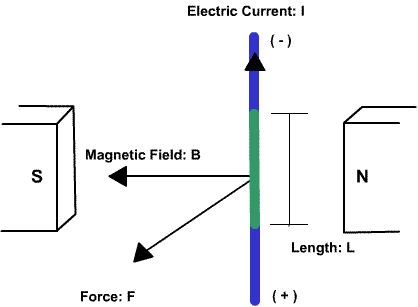|
When an electric charge moves through a
magnetic field, there is a force on the charge,
perpendicular to the direction of the charge and the
direction of the magnetic field. This force is called
the Lorentz Force. This also applies to electric current
in a wire. The direction of the force is demonstrated by
the Right Hand Rule.
Questions you may have include:
A moving particle with an electric
charge--such as a proton or electron--creates a magnetic
field. If that charge is moving through an external
magnetic field there will be an attraction or repulsion
force, as the magnetic interact.
There is a relationship between the
movement of the particle through the magnetic field, the
strength of that magnetic field and the force on the
particle. The following equation describes the force:
F = q*v*B
where F is the force in Newtons, q is
the electric charge in Coulombs, v is the velocity of
the charge in meters/second, and B is the strength of
the magnetic field in Teslas.
If instead of a moving charge such as an
electron or proton, there was electric current through a
wire, the force would a result of the current and the
magnetic field:
F = B*I*L
where F is the force in Newtons, B is
the strength of the magnetic field in Teslas, I is the
electrical current in Amperes, and L is the length of
the wire through the magnetic field in meters.

Force on wire with current flowing
This force on the wire can be measured
in an experiment.
The direction of the force for a given
direction of current and magnetic field can be
remembered by the Right Hand Rule. If you took your
right hand and stuck your thumb up, your forefinger or
first finger forward, and your second finger
perpendicular to the other two, then the directions
would be as indicated in the drawing below.

Force on moving charge through magnetic
field (Right Hand Rule)
The Right Hand Rule is supposed to help
you remember which way things are pointing for the force
on a moving charge. But personally, I think it is
confusing. Still, you should be aware of it, because
some teachers include it in tests.
A good question about the directions of
things in this example, is: "Why are they using a
positive (+) charge moving through the field instead of
an electron, which has a negative (-) charge?"
The reason has to do with the
unfortunate convention that electricity in a wire
travels from (+) to (-), when in reality the electrons
go through the wire in the opposite direction. Saying
that a positive (+) charge travels through the magnetic
field in one direction is the same as saying the
electric current goes in that same direction.
It is just a confusing convention that
you have to remember.
The Lorentz Force is applied to an
electric charge that moves through a magnetic field. It
is perpendicular to the direction of the charge and the
direction of the magnetic field. The direction of the
force is demonstrated by the Right Hand Rule. |